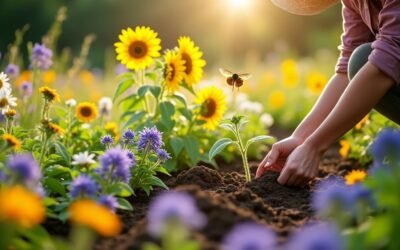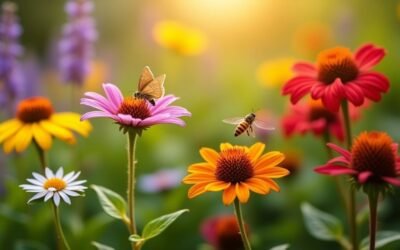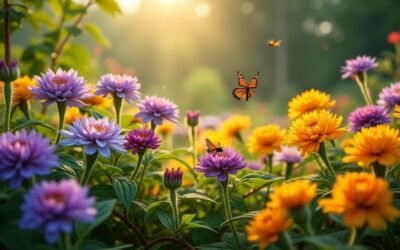The genus *Salvia*, widely recognized as sage, consists of over 900 diverse species, each contributing to culinary and medicinal practices. Commonly characterized by square stems and vibrant, tubular flowers, these plants thrive in well-drained, organic soil, requiring full sunlight for at least six hours daily. Flowering from late spring through summer, *Salvia* attracts essential pollinators like bees and butterflies, enhancing local ecosystems. However, they need careful maintenance to prevent pests and diseases, particularly with proper drainage and air circulation. Understanding these aspects of *Salvia* can deepen appreciation for this remarkable genus and its many wonders.
Main Points
- The genus *Salvia* includes over 900 species, with *Salvia officinalis* commonly known as culinary sage.
- Salvia thrives in full sun, requiring well-drained, organic soil for optimal growth and water management.
- Flowering occurs from late spring through summer, featuring colorful tubular flowers that attract various pollinators.
- The unique staminal lever mechanism enhances pollination, promoting genetic diversity within Salvia species.
- Regular care, including pest monitoring and proper airflow, is essential for preventing diseases like powdery mildew and ensuring healthy plants.
Introduction
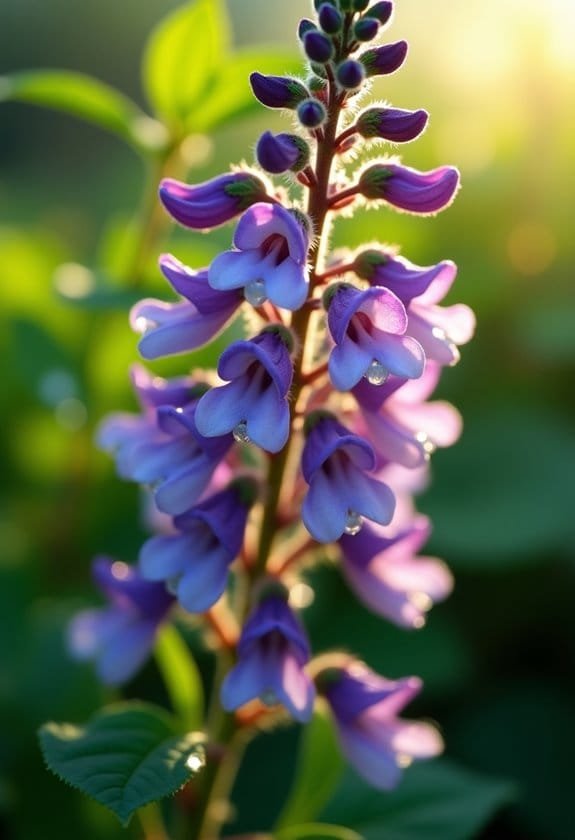
The genus *Salvia*, commonly referred to as sage, encompasses over 900 species, showcasing a remarkable variety of forms and colors that thrive in diverse environments.
Within this vast expanse, *Salvia officinalis*, known as common sage, stands out for its culinary and medicinal significance, featuring aromatic foliage that enhances numerous dishes and remedies.
As the blooming period unfolds from late spring through early fall, these plants play a vital role in supporting pollinator species, ultimately contributing to the richness of local ecosystems.
Common Name
Numerous species within the genus *Salvia* are commonly referred to as "sage," a name that stems from the Latin word *salvia*, meaning "to be well." This term not only highlights the historical importance of these plants in medicinal practices but also encompasses a wide range of species, from culinary varieties like *Salvia officinalis*, known as common sage, to ornamental ones such as *Salvia splendens*.
Over 900 species lie within the *Salvia* genus, showcasing diverse characteristics and uses. Common sage, prized for its culinary applications, embodies a rich tradition of herbalism that dates back to ancient civilizations.
Meanwhile, ornamental species like *Salvia splendens* and *Salvia nemorosa* delight gardeners with their vibrant blooms, enhancing aesthetic appeal in landscapes. Other notable species, including *Salvia elegans*, known as pineapple sage, boast aromatic foliage, while *Salvia coccinea*, or scarlet sage, attracts pollinators with its striking red flowers.
This versatility of "sage" underscores the genus's ecological significance, bridging the gap between functional use in kitchens and ornamental beauty in gardens. Consequently, *Salvia* serves as both a culinary staple and a garden favorite, embodying healing and visual allure.
Scientific Name
Many enthusiasts of botanical nomenclature recognize sage scientifically as *Salvia officinalis*. This well-known plant belongs to the Lamiaceae family, which is celebrated for its aromatic properties and culinary uses.
As a member of the extensive genus *Salvia*, which includes nearly 1,000 species, *Salvia officinalis* stands out for its significance in cooking and traditional medicine. The name *Salvia* is derived from the Latin word 'salveo,' meaning 'to be well', emphasizing its historical role in herbal remedies.
Taxonomically, *Salvia* is classified within the tribe Mentheae of the subfamily Nepetoideae, highlighting its close relationships with other aromatic herbs within the mint family.
Various other notable *Salvia species*, such as *Salvia nemorosa* (woodland sage) and *Salvia splendens* (scarlet sage), capture attention for their ornamental beauty.
Culinary sage, with its robust, earthy, and slightly peppery flavor, isn't just a kitchen staple; it's also a plant woven deeply into cultural practices and medicinal lore.
Through understanding the scientific naming of sage and its relatives, one can appreciate the broader family dynamics of these aromatic herbs found worldwide, particularly thriving in the Americas where diversity flourishes.
Overview
Encompassing a rich diversity of species, the genus *Salvia* holds a prominent place in both horticulture and herbal medicine. With over 900 species primarily native to the Americas, these plants flourish in a range of climates, from USDA hardiness zones 3 to 11.
Characterized by square stems and opposite leaves, *Salvia* plants produce vibrant blooms in colors such as blue, purple, pink, and red, often formed in clusters or spikes that captivate garden enthusiasts.
*Salvia officinalis*, one of the most renowned species, is celebrated for its culinary applications, serving as a flavorful seasoning herb in various dishes. Beyond its culinary merits, the genus also offers medicinal properties, utilized in traditional remedies for numerous ailments.
More than simply ornamental or functional, *Salvia* species play a crucial role in supporting local ecosystems, attracting essential pollinators like bees, butterflies, and hummingbirds, thereby enhancing biodiversity.
Their varied growth forms, which include annuals, perennials, and shrubs, render *Salvia* remarkably adaptable for diverse garden styles and landscapes, promising both ecological and aesthetic benefits.
As gardeners and herbalists continue to explore these attributes, the significance of *Salvia* in enriching both our plates and our pollinator populations becomes increasingly clear.
Key Features
Salvia species exhibit a remarkable variety in growth size, typically ranging from 12 inches to 3 feet tall, creating visually striking displays in gardens.
Their appearance is distinctive, characterized by square stems and opposite leaves, which provide a robust structural framework for the vibrant blooms that flourish in various colors during the summer and fall months.
Understanding these key features of Salvia not only enhances one's appreciation of its ornamental value but also aids in selecting the right species for specific landscapes or ecological purposes.
Growth Size
When considering the growth size of Salvia species, it's clear that they encompass a remarkable range of shapes and sizes. This diversity presents a valuable opportunity for gardeners, particularly when designing perennial borders.
Some Salvia varieties act as low ground covers, typically reaching around 1 foot tall, while others, like the robust Salvia greggii, can tower at heights of 3 feet or more. The bushy growth habits of many species often exhibit widths that equal or exceed their heights, creating a visually striking presence in any garden.
In addition to height, leaf size varies considerably among Salvia types. For instance, Salvia officinalis boasts leaves that grow up to 5 inches long, elegantly contributing to the plant's overall aesthetic.
Flower spikes, typically around 1 inch in size, add vertical interest and can vary in length, further enhancing the overall appearance when in full bloom. Distinctively, compact cultivars such as Compacta highlight this genus's growth size variability, with a modest stature of just 10 inches.
Therefore, understanding and appreciating the growth size of Salvia species is essential for effective garden planning and design.
Appearance
One can't help but admire the striking features of Salvia species. These plants are characterized by their distinct square stems, an emblematic trait of the Lamiaceae family, and opposite leaf arrangement, which enhances their aesthetic appeal.
The leaves themselves vary widely in color—from gray to gray-green, and even purple or golden hues—often exuding delightful aromas that attract curious passersby.
The appearance of Salvia is further elevated by their unique flowering spikes. These spikes showcase tubular, two-lipped flowers that bloom in an array of vibrant colors, including striking blue, purple, pink, red, and white. This diversity in flower color plays a crucial role in pollination, drawing bees, butterflies, and other beneficial insects to gardens.
Salvia species typically grow from 1 to 3 feet tall, displaying a range of habits from low ground covers to more upright shrubs.
With average flower sizes around 1 inch, their overall appearance can add significant visual impact to any landscape. The combination of unique foliage and enchanting floral displays creates a multi-dimensional beauty that makes Salvia a favorite among gardeners and nature lovers alike.
Flowering Season
Blooming typically runs from late spring through summer for Salvia species, with certain varieties extending their colorful display into fall and even surviving until the first frost.
These flowering plants adapt well to ideal environmental conditions, such as full sun and well-drained soil, which greatly enhances their blooming duration.
With their striking spikes or clusters, Salvia flowers exhibit hues ranging from vivid blue and deep purple to soft pink and bright red, creating a visual feast in gardens.
Notably, different Salvia species display unique peak flowering periods. For example, Salvia leucantha is particularly renowned for its enchanting blooms from late summer into fall, engaging gardeners and pollinators alike.
The vibrant flowers of Salvia attract an array of beneficial wildlife, including bees, butterflies, and hummingbirds, thereby playing an essential role in promoting local biodiversity.
Growing Requirements
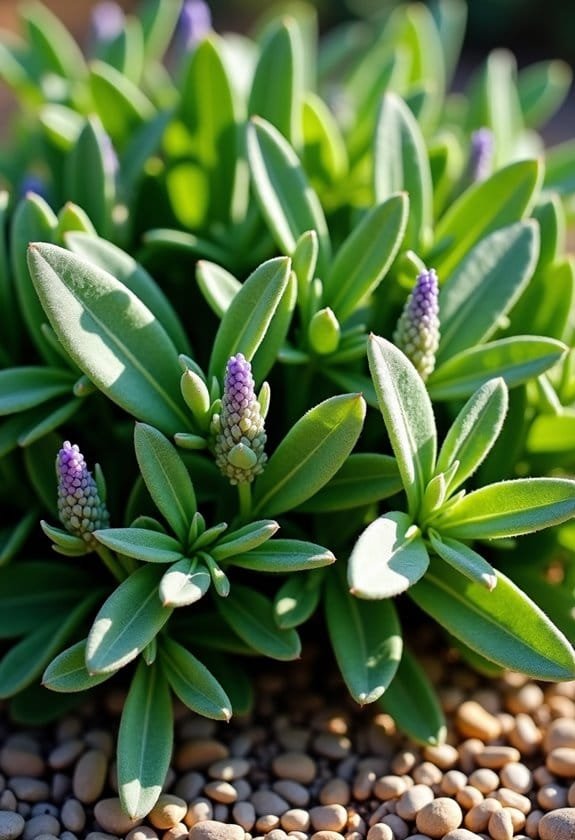
Salvia species flourish under specific growing requirements that greatly influence their robustness and appeal.
They prefer full sun to partial shade, thriving in well-drained, rich soil with slightly dry conditions, which mimics their natural habitats.
Water needs are minimal due to their drought tolerance, allowing them to excel in various climates, yet understanding these conditions guarantees their vibrant blooms and healthy growth through the seasons.
Light
For vibrant blooms and healthy foliage, these plants thrive in full sun to partial shade, needing at least six hours of direct sunlight each day. When positioned correctly, Salvia species exhibit their most spectacular growth patterns and bloom profusely. Light is a crucial factor that influences the overall health of the plants, impacting their photosynthesis processes, which in turn fuels growth and flowering.
Many varieties adapt well to hot, arid conditions or temperate climates, emphasizing the significance of selecting species based on their specific light preferences. For instance, those hailing from savanna or desert environments are adapted to withstand heat, while other species flourish under moderate conditions.
Additionally, regular spring pruning can notably enhance light penetration throughout the plant, allowing lower leaves to reach the sunlight they crave, thereby promoting better flower production. Inadequate light can lead not only to stunted growth but also to increased susceptibility to diseases, highlighting the necessity of a well-considered planting strategy.
Soil
Healthy growth in Salvia species isn't just about light; the right soil conditions are equally important. These plants thrive in well-drained, highly organic soil that prevents excessive water retention, which promotes the development of robust root systems. For ideal results, Salvia prefers a soil pH range of 6.0 to 7.0, enabling the effective availability and absorption of nutrients throughout their growth cycle.
Interestingly, many Salvia species exhibit remarkable drought tolerance, showcasing their resilient nature in lean, dry soils, making them ideal for low-water gardens. To create a suitable environment when planting, it's vital to space the plants 18 to 24 inches apart. This spacing engenders proper airflow, greatly reducing the potential for diseases that can arise from moisture retention.
Incorporating organic compost or well-rotted manure at the time of planting further enhances the nutrient profile and improves the overall structure of the soil. Such amendments not only enrich the soil but also foster an ecosystem that allows Salvia to flourish beautifully.
As a result, understanding and implementing the right soil conditions is key to fostering healthy Salvia growth, ultimately transforming gardens into vibrant, resilient landscapes.
Water
Proper watering is essential for the thriving of Salvia species, especially during their initial establishment. These plants thrive in well-drained, highly organic soil that encourages rapid drainage, safeguarding against root rot and fostering healthy growth. During the first few weeks, regular watering is vital to guarantee the roots establish firmly within the soil.
Salvia species typically require consistent moisture until they become well-rooted; thereafter, the watering frequency can be greatly reduced. Interestingly, many varieties of Salvia display drought tolerance, making them suitable for low-water gardens. Once established, they can endure prolonged periods without irrigation, showcasing their resilience.
However, it's important to remember that overwatering can be detrimental. Excess moisture increases the risk of fungal diseases, particularly in areas with inadequate drainage, highlighting the necessity of striking a balance.
Optimal water management not only promotes vigorous growth and blooming but also prevents complications arising from poor soil conditions. Hence, gardeners should prioritize both the quantity and frequency of water, skillfully maneuvering the delicate interplay of moisture and drainage to secure a flourishing Salvia garden.
Temperature
Temperature plays an essential role in the growth and development of Salvia species, as these plants exhibit varying degrees of temperature tolerance.
These adaptable plants flourish in full sun to partial shade, requiring at least six hours of sunlight daily. For successful cultivation, gardeners must recognize that specific species have distinct temperature preferences.
For example, Salvia officinalis, a hardy perennial, can endure temperatures as low as -30°F (-34°C), thereby thriving in USDA hardiness zones 4 through 11. In contrast, tender varieties like Salvia splendens are less resilient, demanding warmer conditions to reach their full potential.
Understanding the temperature requirements is vital when selecting Salvia plants for a garden, especially for short-lived perennials, which often necessitate tailored care.
In colder climates, employing winter protection methods, such as mulching or covering, safeguards these plants against extreme temperatures.
By anticipating the specific needs related to temperature, gardeners can enhance both the survival and aesthetic appeal of their Salvia species.
With keen attention to temperatures and hardiness zones, they cultivate vibrant displays that add beauty and biodiversity to their surroundings, illustrating the remarkable adaptability of these enchanting plants.
Pollinator Criteria
Salvia species play an essential role in attracting a diverse array of pollinators, such as bees, butterflies, and hummingbirds, thanks to their vibrant colors and abundant nectar.
The intricate staminal lever mechanism, a unique feature of many Salvia flowers, facilitates efficient pollen transfer by engaging pollinators more effectively during feeding. Interestingly, like Common Vetch, these plants contribute to ecosystem health through their nitrogen-fixing capabilities, enhancing soil quality and supporting diverse plant communities.
This symbiotic relationship underscores the significance of these plants in supporting pollinator populations while ensuring reproductive success through their specialized pollination methods. Additionally, incorporating pollinator-friendly plants like Large Thyme can further enhance garden biodiversity and provide vital resources for these essential creatures.
Attracted Pollinators
When considering attractive plants for pollinators, the vibrant flowers of Salvia species stand out as highly effective options. These plants feature bright, tubular blooms in shades ranging from purples to striking blue flowers, alluring a variety of pollinators, including bees, butterflies, and hummingbirds. Their dynamic colors and accessible nectar create a veritable feast during their blooming period, which spans from late spring through summer and into fall, therefore providing a continuous food source for these vital creatures.
Particularly significant are Salvia coccinea (Scarlet Sage) and Salvia elegans (Pineapple Sage), which draw diverse pollinator species, thanks to their intense coloration and delightful fragrance.
The unique staminal lever mechanism in Salvia flowers plays an essential role in promoting effective pollen transfer, as it guarantees that pollinators acquire pollen while foraging. Through such interactions, Salvia plants not only support various pollinator species but also enhance biodiversity within local ecosystems. Interestingly, some gardens also benefit from the presence of other plants like Yellow Archangel, which offer additional aesthetic value and resilience for pollinator habitats.
This makes them invaluable additions to any garden, contributing to the overall health of pollinator populations.
Fundamentally, incorporating Salvia species nurtures ecological balance, fostering a thriving environment for both plants and the pollinators they attract.
Pollination Method
Pollination in Salvia species is a fascinating process that heavily relies on their unique staminal lever mechanism. This mechanism features two stamens that, when probed by pollinators, distribute pollen effectively onto their bodies.
The pollination method requires that bees and butterflies insert their mouthparts into the tubular flowers, which guarantees that only those equipped with long tongues can access the nectar while triggering the lever action necessary for pollen transfer.
The bright, contrasting colors of Salvia blooms act as visual cues, enticing these essential pollinators to engage with the flowers in their search for sustenance. This interaction isn't merely happenstance; it plays a vital role in the success of seed development.
Some Salvia species even exhibit structural adaptations that enhance pollen transfer between individual plants, promoting genetic diversity.
Furthermore, the relationship between Salvia and its pollinators emphasizes a delicate balance within ecosystems, where effective pollination can enhance biodiversity and the overall health of habitats.
Ultimately, this intricate dance between Salvia flowers and their visiting bees and butterflies illustrates nature's extraordinary efficiency and beauty in guaranteeing reproductive success.
Care & Maintenance
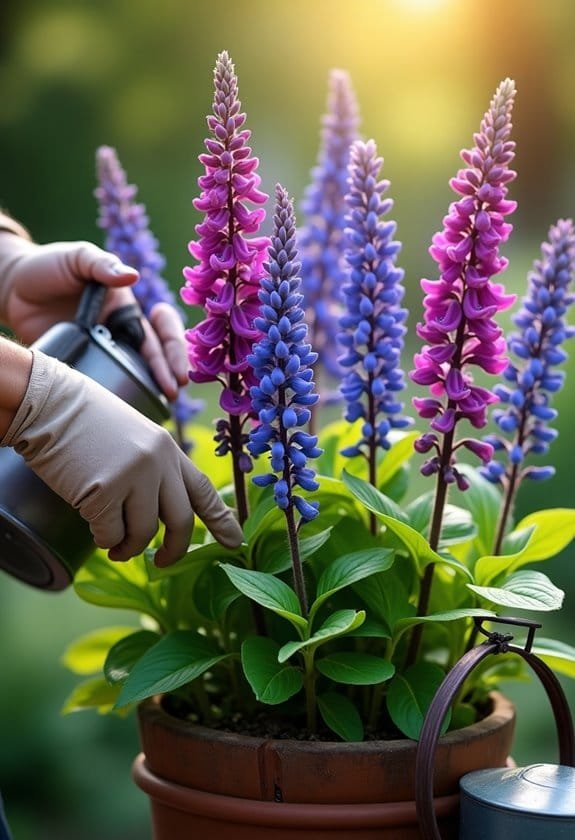
When it comes to the care and maintenance of Salvia species, understanding the ideal planting conditions is essential for thriving plants.
These robust perennials prefer environments that offer full sun to partial shade and well-drained, organic soil; this foundation guarantees their persistent growth and vibrant blooms.
Additionally, regular pruning, strategic spacing of 18 to 24 inches, and thoughtful pairing with companion plants will greatly enhance their health and aesthetic appeal in any garden.
Planting Tips
Planting Salvia requires attention to a few key factors to guarantee vibrant growth and blooming.
First, it's important to position the plants in full sun to partial shade, promoting ideal photosynthesis. Ensuring the well-drained soil is rich in organic matter will foster healthy root development, which is fundamental for flowering.
Spacing is equally important; Salvia plants should be planted 18 to 24 inches apart. This allows for good air circulation, greatly reducing the risk of diseases such as powdery mildew.
During the initial planting phase, a gentle pruning in spring can stimulate new growth while preventing legginess, resulting in a bushier appearance that enhances visual appeal.
When it comes to watering, deep yet infrequent irrigation is recommended, especially during dry conditions, as Salvia possesses drought-tolerant characteristics.
Finally, vigilant monitoring for common pests like aphids and spider mites is critical.
Regular checks on air circulation and drainage effectively prevent detrimental conditions such as root rot.
Ongoing Care
How can gardeners guarantee their Salvia plants thrive throughout the growing season? Ongoing care is essential for these resilient herbs, which favor full sun to partial shade and well-drained, organic soil.
Once established, Salvia plants require minimal watering—an appealing trait for low-maintenance gardens. To cultivate bushier growth, regular pruning in the spring is advisable. This practice also helps reduce legginess, while ensuring ample spacing of 18 to 24 inches between plants enhances air circulation, thereby diminishing the risk of disease.
In addition, routine division every couple of years can revitalize Salvia plants, preventing overcrowding and sustaining their health over time.
While Salvia species exhibit impressive drought and salt tolerance, vigilance against common pests and diseases is paramount. Spider mites and powdery mildew often present challenges that can impede robust flowering. By monitoring these issues and implementing early interventions, gardeners foster a thriving environment.
In cultivating these stunning plants, integrating proper ongoing care transforms not only the garden but also the well-being of the Salvia, promising a flourishing display throughout the season.
Suggested Companions
Integrating companion plants with Salvia can enhance the health and beauty of a garden. When choosing companions, gardeners should prioritize species that share similar water and sunlight requirements, such as lavender, rosemary, and thyme. These aromatic companions not only foster a harmonious environment but also create an appealing sensory experience. Additionally, incorporating Potentilla species which attract pollinators can create a vibrant and ecologically beneficial atmosphere in the garden.
Incorporating native wildflowers like coneflowers and black-eyed Susans can markedly enhance pollinator attraction, thereby supporting biodiversity within the garden ecosystem.
Grouping Salvia with drought-tolerant plants like succulents and sedums also promotes a low-maintenance landscape, helping to optimize water usage.
To maintain both health and aesthetics, it's important to space companion plants adequately. This spacing allows for good air circulation, reducing the risk of powdery mildew—a common affliction for both Salvia and its neighbors.
When selecting ornamental grasses as companions, opt for varieties that thrive in similar soil conditions, ensuring they complement the visual appeal of the garden while minimizing nutrients competition. Additionally, incorporating plants such as white bryony can enhance overall ecosystem support due to its role in attracting various pollinators.
Common Issues
Salvia species, while resilient, frequently confront challenges from various pests and diseases that can threaten their significance and beauty.
Common invaders, such as whitefly and aphids, exploit vulnerabilities in plants, particularly under conditions of poor air circulation and overly moist soil, where diseases like powdery mildew can flourish.
Addressing these issues proactively—through regular monitoring, maintaining ideal growing conditions, and keeping the garden tidy—ensures that Salvias thrive, showcasing their remarkable charm.
Pests/Diseases
Plants often face challenges from various pests and diseases, particularly Salvia species. These resilient herbs, though robust, can be plagued by bothersome insect pests such as whiteflies, aphids, mealybugs, and spider mites. These pests sap the vigor from Salvia plants, leading to weakened growth and diminished health.
On the disease front, fungal infections like rust, powdery mildew, stem rot, and fungal leaf spots can pose significant threats. Often emerging due to conditions like poor air circulation and excessive watering, these diseases hinder plant development and robustness.
To combat pests and diseases, maintaining well-drained soil is essential, as it fosters healthy roots while promoting ideal airflow around the plants. Regular plant health monitoring allows for early detection of infestations or infections, which is critical for implementing timely management strategies.
Healthy Salvia plants typically show remarkable resilience against common pests and herbaceous diseases, underscoring the importance of providing ideal growing conditions. By understanding these challenges, gardeners can take proactive measures, leading to flourishing Salvia species that not only enhance gardens but also contribute to biodiversity.
Solutions
Addressing common issues with Salvia species often begins with implementing effective pest and disease management strategies. Key pests like whiteflies, aphids, mealybugs, and spider mites can severely hinder growth and flowering, so regular monitoring is essential. Early detection enables prompt intervention, minimizing damage to the plants and maintaining their vigor.
Additionally, Salvia plants are prone to diseases such as rust, powdery mildew, stem rot, and fungal leaf spot, particularly in poorly drained soils or high humidity. As a result, ensuring suitable soil conditions is crucial.
Maintaining healthy soil with excellent drainage not only prevents root rot but also promotes overall plant health and resilience against illnesses. The addition of organic matter can enhance soil fertility, encouraging robust growth.
In addition, proper plant spacing and air circulation alleviate conditions that foster fungal development. By utilizing deer-resistant varieties of Salvia, gardeners can also protect their plants from herbivore damage, making them invaluable in diverse planting settings.
Ultimately, through diligent care and strategic adjustments, gardeners can mitigate common challenges while ensuring vibrant growth and blooming of Salvia species.
Summary
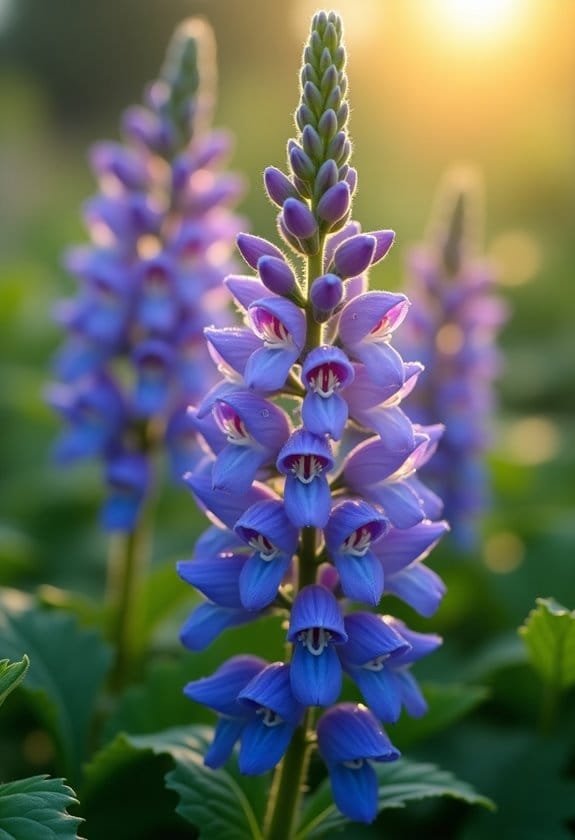
While often associated with culinary and aromatic uses, the genus Salvia encompasses a diverse array of over 900 species known for their adaptability and ecological importance. Primarily found in the Americas, these hardy plants belong to the mint family and display a spectrum of growth habits, including annuals, perennials, and shrubs.
Salvia officinalis, commonly referred to as common sage, is cherished for its fragrant leaves and culinary applications, while Salvia elegans, or pineapple sage, finds favor in aromatherapy.
These species generally bloom from late spring through summer, effectively attracting a variety of pollinators such as bees, butterflies, and hummingbirds, which enrich local ecosystems. Salvia species demonstrate remarkable resilience, thriving in USDA Hardiness Zones 3-11. Some, like Salvia officinalis, endure harsh conditions, tolerating frigid temperatures as low as -30°F (-34°C).
Additionally, many Salvia species harbor medicinal properties, containing compounds that offer anti-inflammatory and antimicrobial benefits. Ongoing research aims to reveal their full health potential, revealing the multifaceted value of these remarkable plants.
Collectively, they embody a rich tapestry of biodiversity, essential for both ecological balance and human well-being.
